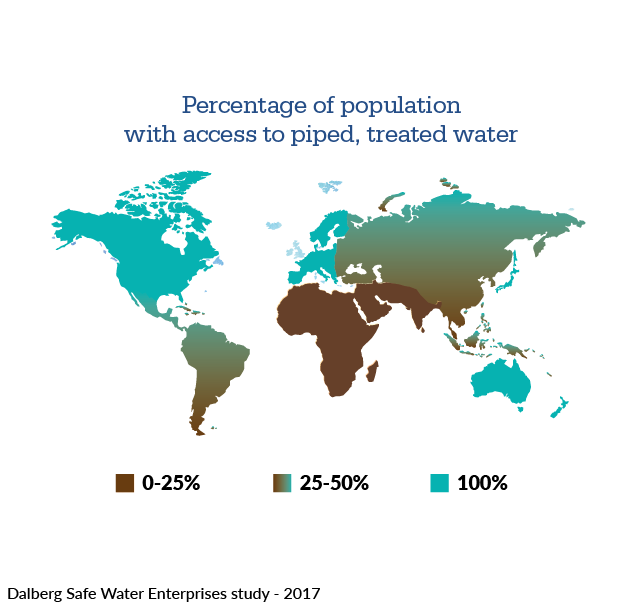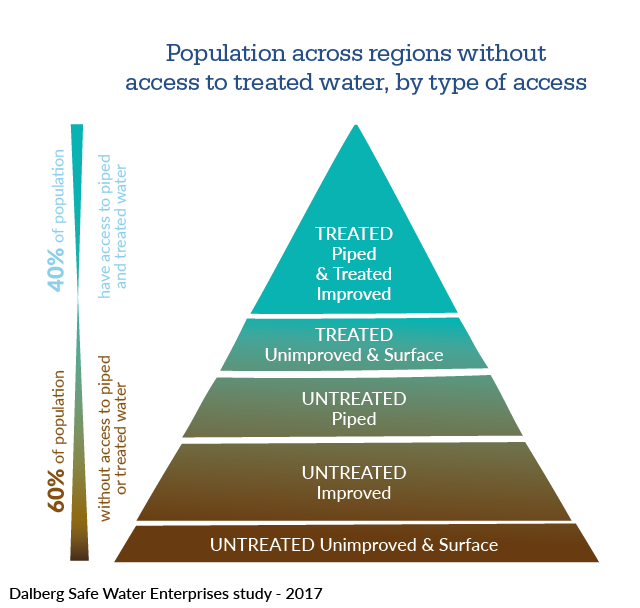Water
The Problem? Access to safe drinking water is a very pressing topic. In many parts of the world, the human right to water and sanitation is not being achieved.
It concerns a lot of people
According to the WHO and UNICEF(1) , 2.1 billion people lacked safely managed drinking water services in 2015, and water related diseases remain endemic in too many countries.
Women and children are worst affected — women and girls because they often bear the burden of carrying water for their families, children because they are more vulnerable to waterborne diseases.
Impact on health is critical
Every year there are more than 3.4 million deaths due to waterborne diseases, making it the leading cause of disease and death around the world.
Lack of access to a safe water source is a leading risk factor for infectious diseases, including cholera, diarrhea, dysentery, hepatitis A, typhoid and polio. It also exacerbates malnutrition, and in particular, stunting in children.
It also has an impact on education and poverty
A study conducted by 1001fontaines and Pr. Hunter (East Anglia University) in Cambodia confirms that absenteeism reduces by 75% in schools where children have access to safe drinking water.
Women and girls often bear the burden of carrying water for their families for an estimated 200 million hours each day. Hours that could have been spent learning at school or generating income.
Many geographies are concerned
Eight out of ten people in rural areas still lack even basic services. Nearly half live in Least Developed Countries.
In 2017, 90% of the 785 million people who still used limited services, unimproved sources or surface water lived in three regions: sub-Saharan Africa (400 million), Eastern and South-Eastern Asia (161 million), and Central and South Asia (145 million). More than half of the 144 million people who still collected water directly from rivers, lakes and ponds lived in sub-Saharan Africa.(2)
(1)UNICEF/WHO “Progress on drinking water, sanitation and hygiene: 2017 update and Sustainable Development Goal baselines”
(2)Progress on household drinking water, sanitation and hygiene 2000-2017: Special focus on inequalities UNICEF and WHO. 2019.


There is a lack of funding
The World Bank estimates that the total capital cost to meet the targets of SDGs 6.1. and 6.2 is USD 114 billion per year, which represents three times the current investment levels.[3] Despite the need, the sector remains chronically underfinanced due to two main factors:
- Lack of investor understanding and experience in the water sector, due to its multifaceted nature (at the crossing point of health, environment, infrastructure, energy access etc);
- Limited familiarity with solutions other than traditional and costly infrastructure investments, which are perceived by developed countries funders as a “government responsibility”.
[3] World Bank. “The Costs of Meeting the 2030 Sustainable Development Goal Targets on Drinking Water, Sanitation, and Hygiene.” Summary Report. 2016.
A solution we believe in
In 2016, Dalberg Global Development Advisors conducted a study on the untapped potential of decentralized Safe Water Enterprises. The report was supported by Danone Communities, Aqua for All, The Stone Family Foundation, Osprey Foundation and Conrad N. Hilton Foundation.
Key findings include the potential to serve billions of people. You can find out more about this study here: http://safewater.enterprises/.
We believe that decentralized entrepreneurial solutions can be a part of the solution to the problem of access to safe drinking water. We aim to invest in systems that increase access to safe drinking water to both rural and urban areas around the world. Because of our expertise in the water kiosk model, we have mainly invested in such systems in the past. However, we are open to investing in other innovative solutions that increase impact and that are scalable through replicable models.
Today, our portfolio includes 9 Safe Water Enterprises (SWEs) and our objective is to continue to develop this sector.
Besides providing affordable safe drinking water to communities, some of our SWEs have also built ‘Water for Schools’ programs, to help provide safe drinking water for free to those who cannot pay for water: children. These ‘Water for Schools’ programs operate in collaboration with the NGO Watering Minds.
Safe Drinking Water Enterprises: An Analysis of Economic Sustainability
This document aims to comprehensively examine safe drinking water enterprises (SDWEs), dedicated to providing safe drinking water solutions to vulnerable consumers. The report will delve into three key areas: firstly, it will discuss the various business models of SDWEs; secondly, it will assess the economic sustainability of these models, distinguishing between those that are commercially viable and those require financing; and thirdly, it will meticulously explore the internal and external factors influencing the growth of SDWEs.




